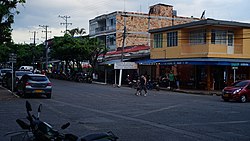|
Cumaral
Cumaral is a town and municipality in the Colombian department of Meta. NameThe municipality derives its name from the abundance of Cumare palms that were prevalent during its early years of establishment.[3] HistoryCumaral was officially founded in 1901 at a site known as "Laguna Brava" or "Laguna del Pueblo", but an outbreak of yellow fever forced the relocation of its inhabitants. By 1917, settlers moved to an area with cumare palm plantations called "Tierra Alta." The settlement was initially referred to as "Boca de Monte."[4] The earliest records of Cumaral's history were documented by Father Fray Agustín Gómez, Parish Priest of San Juan de Arama. In a report dated October 15, 1750, addressed to Father Fray Clemente Forero, commissioner of the Llanero reductions, Father Gómez mentioned various indigenous tribes, including the Camoas of San Martín. He also noted that indigenous people had long inhabited the area inland from the original town of Cumaral, which had ceased to exist by that time.[5] Modern-day Cumaral began to take shape in 1917, approximately six kilometers north of Laguna del Pueblo, near the Guacavía River. This new settlement was founded on land donated by General Avelino Rosas. Initially named Boca de Monte, the settlement marked the boundary between the dense jungle covering the foothills from Villavicencio to Restrepo and the start of the savanna. The founding of Boca de Monte was spearheaded by notable figures, including Manuel Saavedra Hernández, Eustorgio Pinzón Machado, Faustino Pulido Rojas, Próspero A. Peña, Jorge Varela, José Genay, David Hernández, and Oliverio Castro. Political-Administrative DivisionIn addition to its municipal seat. Cumaral has jurisdiction over the following populated centers: Guacavía Presentado San Nicolás Veracruz GeographyCumaral has a typical landscape of the Llanero foothills, featuring a flat topography with formations of undulations and estuaries.[4] Climate
References
Information related to Cumaral |
||||||||||||||||||||||||||||||||||||||||||||||||||||||||||||||||||||||||||||||||||||||||||||||||||||||||||||||||||||||||||||||||||||||||||||||||||||||||||||||||||||||||||||||||||||||||||||||||||



